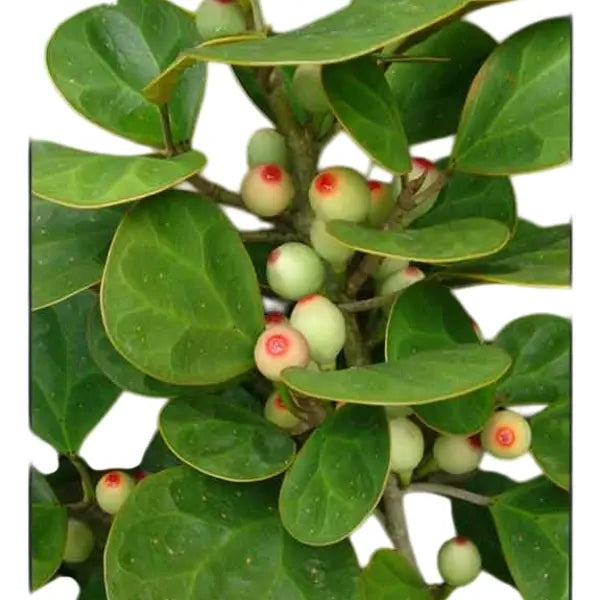
Mistletoe Fig (Ficus Deltoidea Gold)
Selling Size : Single Plant | Pot Included | Secure Packing
The Mistletoe Fig (Ficus deltoidea), also known as the Delta Fig, is a beautiful and relatively low-maintenance houseplant that is prized for its unique, glossy leaves and small, non-edible figs that it produces year-round. The 'Gold' variety is particularly sought after for its striking leaves that are dark green on top and have a distinctive golden-yellow underside, often with triangular black glands.
Here is a comprehensive guide to caring for your Mistletoe Fig:
1. Light
Bright, Indirect Light: This plant thrives in bright, indirect sunlight. A spot near a south, east, or west-facing window is ideal.
Avoid Direct Sun: While some sources suggest it can tolerate full sun, intense, direct sunlight can scorch the delicate leaves. Filtered light is best to prevent leaf burn.
Low Light Tolerance: Ficus deltoidea can tolerate lower light conditions, but its growth may slow, and it may not produce as many figs.
2. Watering
Consistent Moisture, Not Soggy: The Mistletoe Fig prefers consistently moist soil, but it's crucial to avoid overwatering, as this can lead to root rot.
Check the Soil: Water the plant when the top inch or two of the soil feels dry to the touch.
Thorough Watering: When you water, do so thoroughly until water drains from the bottom of the pot.
Reduce in Winter: During the fall and winter, when the plant's growth slows, reduce the frequency of watering.
3. Humidity and Temperature
Humidity is Key: As a tropical plant, the Mistletoe Fig loves a humid environment.
Increase Humidity: To increase humidity, you can:
Mist the leaves regularly.
Place the pot on a tray filled with pebbles and water, ensuring the bottom of the pot is not in the water.
Use a humidifier in the room.
Ideal Temperature: This plant does best in a warm environment, with temperatures between 65°F and 85°F (18°C to 29°C).
Avoid Drafts: Like other Ficus plants, the Mistletoe Fig is sensitive to sudden changes in temperature and cold drafts, which can cause leaf drop.
4. Soil and Potting
Well-Draining Soil: Use a well-draining, loamy potting mix. A good mix can include a combination of potting soil, perlite, and peat moss to ensure proper drainage and aeration.
Repotting: The Mistletoe Fig is known to be a slow grower and prefers to be slightly root-bound. Repot only when necessary, typically every 2-3 years in the spring. Choose a new pot that is only one size larger than the old one.
5. Fertilizing
Growing Season: During the spring and summer, feed your plant with a balanced liquid fertilizer (like a 10-10-10) at half the recommended strength.
Frequency: Fertilize once a month during the growing season.
Dormancy: Do not fertilize in the fall and winter when the plant's growth has slowed.
6. Pruning and Propagation
Pruning: You can prune your Mistletoe Fig to maintain its shape and size, and to encourage a bushier appearance. It responds well to heavy pruning, and can even be used as a bonsai specimen.
Propagation: The most common and effective way to propagate this plant is through stem cuttings. Take a cutting with a few leaves, dip the cut end in a rooting hormone, and place it in a well-draining soil mix. Keep the cutting in a warm, humid environment until roots develop.
Common Problems
Leaf Drop: This is the most common issue and is usually a sign of stress. Causes can include:
Sudden changes in light or temperature.
Overwatering or underwatering.
Being moved to a new location.
Pests: Watch out for common pests like spider mites, mealybugs, and scale insects. Inspect the leaves regularly and treat any infestations with an insecticidal soap or neem oil.

